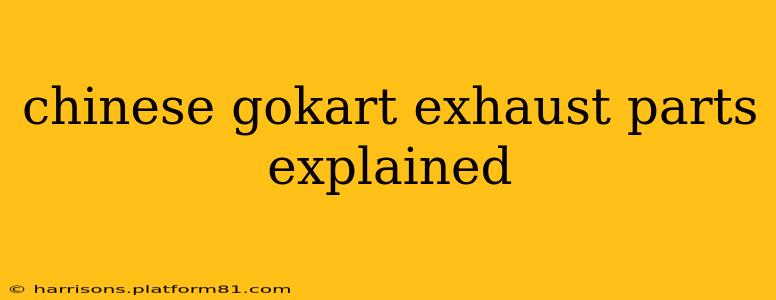The world of go-karting is filled with enthusiasts constantly seeking ways to optimize their machines for speed, handling, and overall performance. A crucial component often overlooked is the exhaust system. Understanding the intricacies of Chinese go-kart exhaust parts is key to unlocking your kart's full potential. This comprehensive guide explores the various parts, their functions, and how modifications can impact your kart's performance.
What are the main components of a Chinese go-kart exhaust system?
A typical Chinese go-kart exhaust system consists of several key components:
-
Exhaust Manifold: This is the first part of the system, collecting exhaust gases from the engine cylinders. Its design significantly influences the flow of gases, affecting engine performance. Many Chinese karts utilize cast iron manifolds, while some higher-performance models might have steel or even more exotic materials.
-
Exhaust Pipe: This is the main pipe that carries the exhaust gases from the manifold to the muffler. The diameter and length of this pipe are crucial factors determining back pressure and ultimately, power output. Different pipe diameters and lengths are experimented with to achieve optimal performance gains.
-
Muffler (Silencer): This component reduces the noise level of the exhaust gases. While primarily for noise reduction, the muffler's design also impacts back pressure. Some mufflers offer more restrictive flow for quieter operation, while others are designed for less restriction, prioritizing performance over noise suppression.
-
Exhaust Gasket(s): These are essential seals placed between the engine's exhaust port and the manifold, and between the manifold and exhaust pipe. Properly sealing these connections prevents exhaust leaks that rob power and damage the engine.
What materials are commonly used in Chinese go-kart exhaust parts?
Chinese go-kart exhaust parts are commonly constructed from several materials, each with its own strengths and weaknesses:
-
Cast Iron: A common and cost-effective material for manifolds. It's durable but can be heavy and less efficient in heat dissipation compared to other materials.
-
Steel: Often used for the exhaust pipe, steel offers a good balance of strength, durability, and heat resistance. Different grades of steel offer varying levels of performance and corrosion resistance.
-
Aluminum: Less common but increasingly used in high-performance applications. Aluminum offers excellent heat dissipation, reducing engine temperatures and potentially improving performance. It's also lighter than steel or cast iron.
How do exhaust modifications affect go-kart performance?
Modifying your go-kart's exhaust system can significantly impact its performance, but it requires careful consideration.
-
Changing the Exhaust Pipe Diameter: A larger diameter pipe generally reduces back pressure, allowing for easier exhaust gas expulsion and potentially increasing horsepower. However, an excessively large diameter can decrease low-end torque. Experimentation is key to finding the optimal balance.
-
Modifying the Exhaust Pipe Length: Exhaust pipe length influences the tuning of the engine. Adjusting the length can alter the pressure waves within the exhaust system, optimizing power at specific RPM ranges. This is a more advanced modification and often requires detailed understanding of engine tuning principles.
-
Replacing the Muffler: A less restrictive muffler (or even removing the muffler entirely – not recommended for most situations due to noise regulations) reduces back pressure and can improve horsepower. However, this significantly increases noise levels.
What are the common problems with Chinese go-kart exhaust parts?
While often cost-effective, some common issues with Chinese go-kart exhaust parts include:
-
Poor Quality Materials: Some lower-priced parts may use inferior materials that are prone to rust, cracking, or premature failure.
-
Inconsistent Manufacturing: Variations in manufacturing tolerances can lead to leaks or improper fitment.
-
Lack of Technical Support: Finding replacement parts or technical assistance for lesser-known brands can be challenging.
How can I choose the right exhaust parts for my Chinese go-kart?
Selecting the appropriate exhaust parts depends on your go-kart's engine specifications, desired performance goals, and budget. Consider these factors:
-
Engine Size and Type: Different engine sizes and types require exhaust systems optimized for their specific characteristics.
-
Performance Goals: If you prioritize top speed, a less restrictive exhaust system might be preferable. For improved low-end torque, a more restrictive system might be a better choice.
-
Budget: Prices vary widely depending on the materials and construction quality.
-
Noise Regulations: Check local noise regulations before making modifications that significantly increase the exhaust noise.
This comprehensive overview provides a solid foundation for understanding Chinese go-kart exhaust parts. Remember to always prioritize safety and comply with local regulations when modifying your go-kart. Further research into specific engine types and performance tuning will help you optimize your kart's exhaust system for maximum performance.
